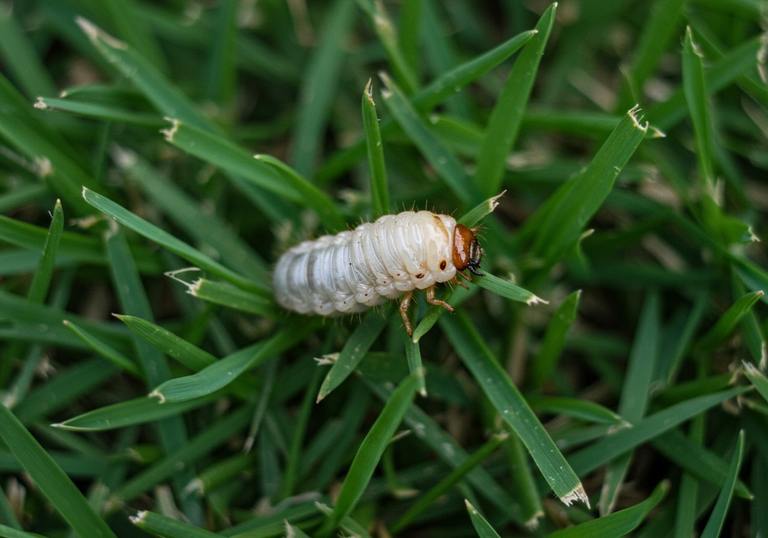Grub Trouble? How to Defend Your Lawn from Underground Invaders
Published: April 16, 2025

Introduction
If you’ve ever noticed patches of dead grass that seem to appear out of nowhere, or if your lawn feels spongy underfoot, you may be dealing with one of the most frustrating lawn pests: grubs. These small, white, C-shaped larvae are the immature form of various beetles and can cause major damage to lawns and landscapes across Southwest Florida.
At All U Need Pest Control, we specialize in protecting your lawn from pests like grubs, offering professional and effective solutions tailored to the local climate and pest conditions. In this blog, we’ll cover what grubs are, the damage they cause, signs of infestation, and how to control them.
What Are Grubs?
Grubs are the larval stage of several types of beetles, including Japanese beetles, June beetles, and chafer beetles. These larvae live underground and feed on the roots of grass and other plants. Because they remain hidden beneath the surface, many homeowners don’t notice them until they’ve already done significant damage.
Grubs typically appear in late summer to early fall, when beetles lay eggs in the soil. Once hatched, the larvae begin feeding, weakening grass from the roots up. If left untreated, a grub infestation can destroy large areas of a lawn.
Signs You Have a Grub Problem
Grub infestations can be tricky to detect early on. However, here are some common signs that grubs may be invading your lawn:
- Brown or patchy grass that lifts up easily like a carpet
- Increased animal activity such as raccoons, skunks, or birds digging for food
- Spongy or soft turf when walked upon
- Thinning grass, despite watering and fertilizing
If you notice one or more of these signs, it’s time to investigate beneath the surface. Pull up a small section of turf and look for white, curled larvae just below the topsoil.

How Grubs Damage Your Lawn
The primary damage caused by grubs is to the root systems of grass. By feeding on the roots, grubs prevent grass from absorbing water and nutrients, causing sections of your lawn to die off. Severe grub infestations can result in significant bare patches and require costly lawn restoration.
Moreover, the presence of grubs attracts other pests like armadillos, raccoons, and birds that dig up your lawn searching for an easy meal—adding even more destruction.
According to a study from the University of Kentucky, grub damage is one of the leading causes of turfgrass failure in residential landscapes.
The Lifecycle of a Grub
Understanding the lifecycle of a grub is key to effective treatment:
- Spring – Grubs from the previous year start to feed again before pupating.
- Early Summer – Adult beetles emerge, mate, and lay eggs in the soil.
- Late Summer/Fall – Eggs hatch and new grubs begin feeding aggressively.
- Winter – Grubs burrow deeper into the soil and become dormant.
Timing treatments with this cycle is crucial. Preventative treatments are most effective in the early summer before grubs hatch, while curative treatments are best in late summer and early fall.

How to Get Rid of Grubs
There are several ways to tackle a grub problem:
1. Preventative Treatments
Treatments that target grubs are effective by preventing them from growing. These solutions are often applied in early summer and can offer lasting protection for your lawn.
2. Curative Treatments
If grubs are already causing damage, treatments can be used to eliminate them. These solutions work quickly, though you may need to apply them again for continued control.
3. Professional Help
Homeowners who want peace of mind and dependable results often find that professional care offers long-term benefits. Routine inspections and treatments can be the difference between catching a minor issue early or dealing with widespread lawn damage later.
For more detailed insights into managing white grubs, check out this article from Northeast IPM.

Why Grub Control Matters in Southwest Florida
Southwest Florida’s warm, humid climate provides ideal conditions for beetles to thrive and reproduce. Without proactive lawn care, grub populations can spiral out of control quickly. Maintaining healthy turf not only boosts curb appeal—it also protects your investment.
Establishing a consistent pest management plan is one of the most effective ways to guard against seasonal threats like grubs. It ensures timely intervention, encourages preventive care, and minimizes the need for reactive treatments. Over time, a scheduled routine can help maintain a lush, resilient lawn year-round.
Call the Grub Control Experts
If you suspect grubs are damaging your lawn, don’t wait until it’s too late. Contact All U Need Pest Control for a thorough inspection and treatment plan. We’ll help you restore your turf and keep it green, lush, and grub-free year-round. Give us a call —and say goodbye to grubs for good.